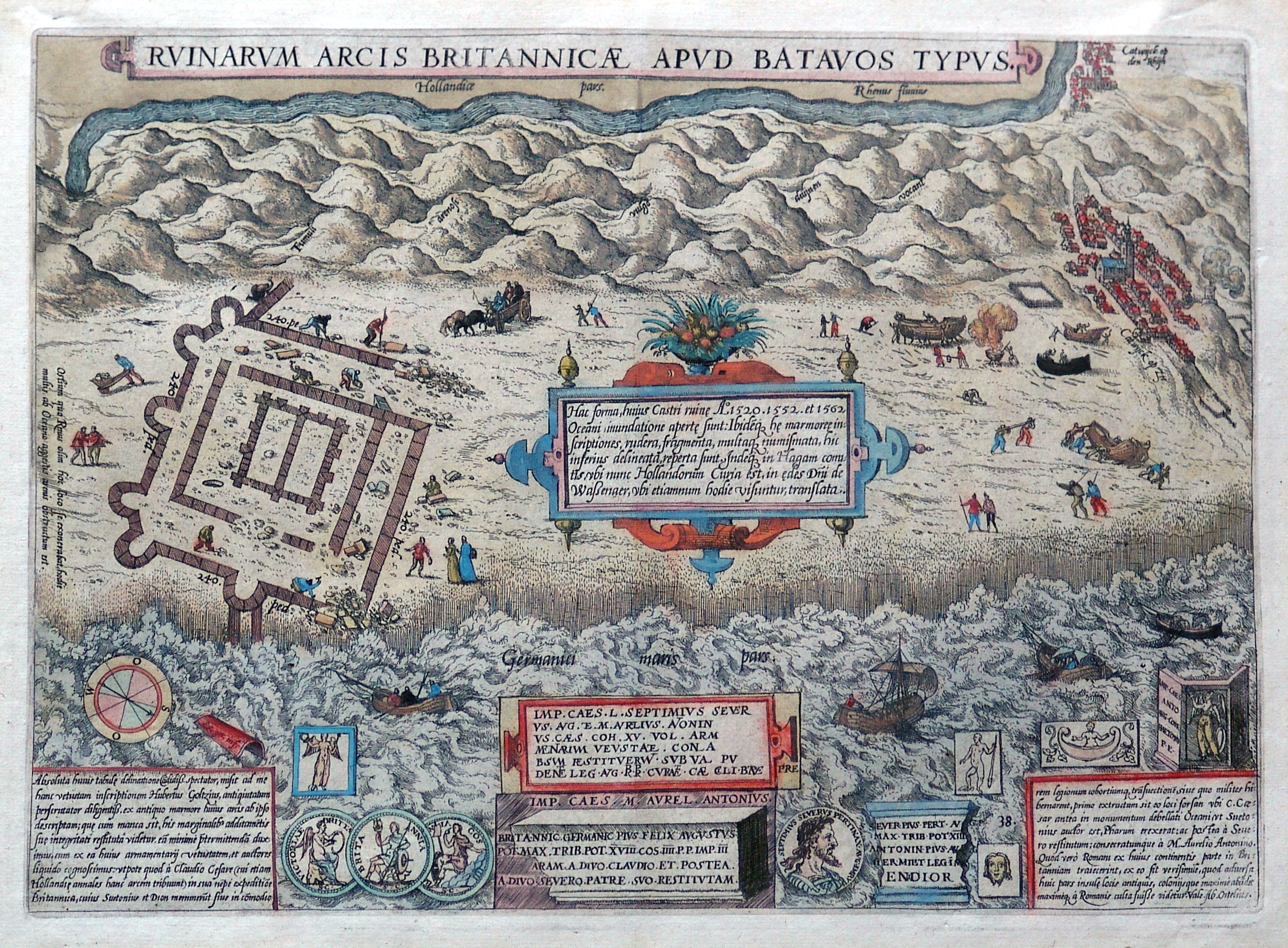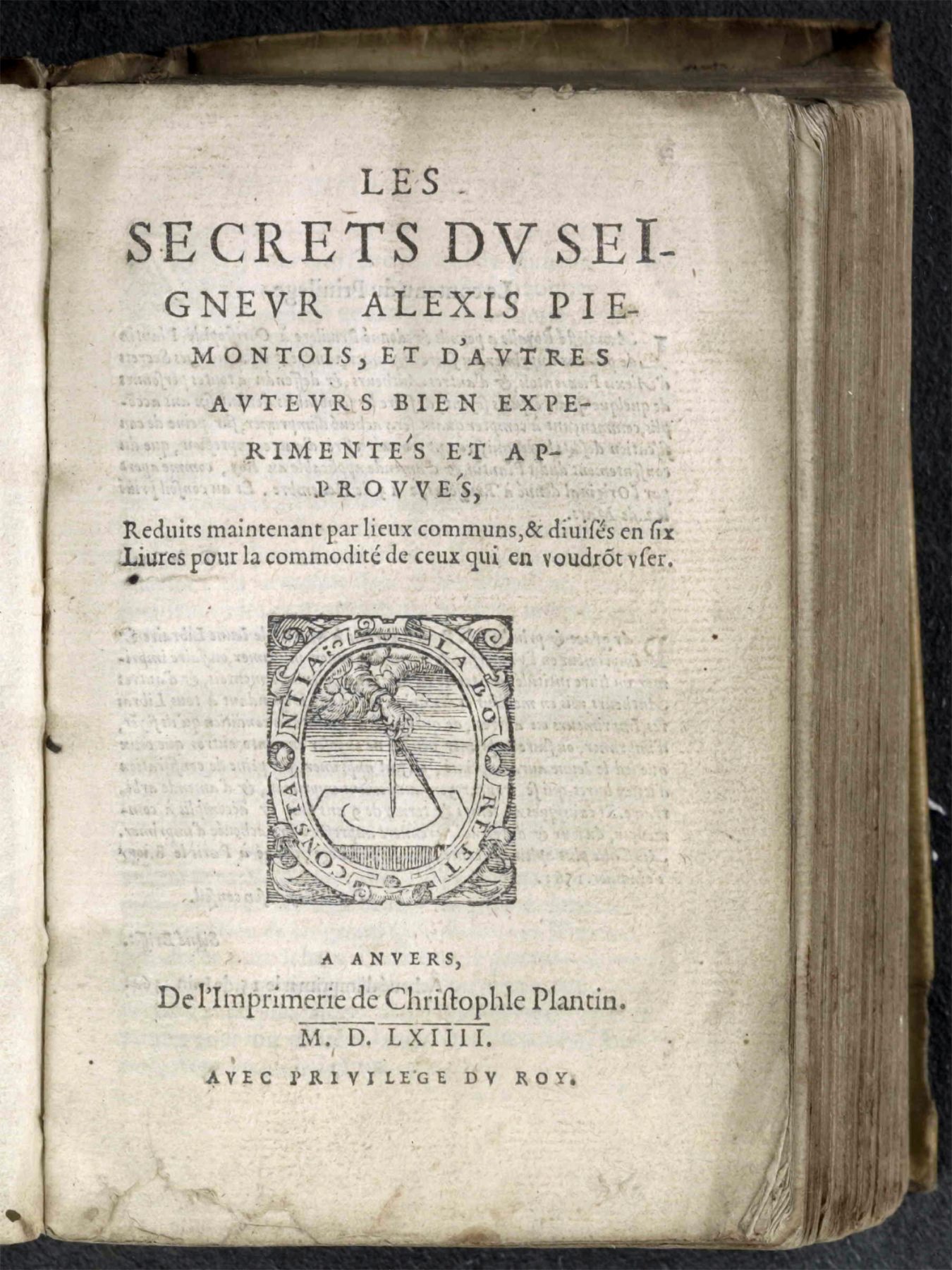|
Lugudunum Batavorum
Brittenburg was a Roman ruin site west of Leiden between Katwijk aan Zee and Noordwijk aan Zee, presumably identical to the even older Celtic Lugdunum fortress. The site is first mentioned in 1401, was uncovered more completely by storm erosion in 1520, 1552 and 1562, and has subsequently been entirely eroded away. When built, it was located at the mouth of the Oude Rijn (old river Rhine), which has since moved. The site was about a kilometre west of the European Space Research and Technology Centre, now offshore in the North Sea). History The word ''dunum'', traceable in Gaelic place names in the present day ( Dundalk, Dunrobin Castle) and meaning "fortress" or "castle", is a typically Celtic element in European place-names. The site, known as "Brittenburg", was still visible in the dunes in the fourteenth century, but the gradual advance of the sea made the ruins lie on the beach in the sixteenth and seventeenth century. Today, they would be somewhere in the Rhine estuar ... [...More Info...] [...Related Items...] OR: [Wikipedia] [Google] [Baidu] |
Valkenburg (South Holland)
Valkenburg () is a village and former municipality in the province of South Holland, in the western Netherlands. Valkenburg is now part of the municipality Katwijk and had a population of 3,900 in 2006. On 1 January 2006, Valkenburg and Rijnsburg were merged into the municipality of Katwijk. The former municipality of Valkenburg had about 3878 inhabitants (1 June 2005) and a surface area of of which is water. On the second Wednesday in September there is a horse market, the oldest in the Netherlands.http://www.demart.nl/page6.aspx Op 8 september 2010 viert Valkenburg de 1066e editie van Neerlands Oudste Paardenmarkt 2010 marked its 1066th year of operation. The former Valkenburg Naval Air Base Valkenburg Naval Air Base (Dutch: Vliegkamp Valkenburg) is a former air base located just south of Valkenburg, which is part of Katwijk and close to the city of Leiden, that was used by the Netherlands Naval Aviation Service until 2006, being t ..., which was situated here since ... [...More Info...] [...Related Items...] OR: [Wikipedia] [Google] [Baidu] |
Antwerp
Antwerp (; nl, Antwerpen ; french: Anvers ; es, Amberes) is the largest city in Belgium by area at and the capital of Antwerp Province in the Flemish Region. With a population of 520,504,Statistics Belgium; ''Loop van de bevolking per gemeente'' (Excel file) Population of all municipalities in Belgium, . Retrieved 1 November 2017. it is the most populous municipality in Belgium, and with a metropolitan population of around 1,200,000 people, it is the second-largest metrop ... [...More Info...] [...Related Items...] OR: [Wikipedia] [Google] [Baidu] |
Christophe Plantin
Christophe Plantin ( nl, Christoffel Plantijn; – 1 July 1589) was a French Renaissance humanist and book printer and publisher who resided and worked in Antwerp. Life Plantin was born in France, probably in Saint-Avertin, near the city of Tours, Touraine. He was not born to a wealthy family, and his mother died when Plantin was still quite young. As a youth he apprenticed as a bookbinder in Caen, Normandy, and also married there. In 1545, he and his wife, Joanna Rivière, set up shop in Paris, but after three years they chose to relocate to the booming commercial center of Antwerp, where Plantin became a free citizen and a member of the Guild of St Luke, the guild responsible for painters, sculptors, engravers and printers. The quality of his work as a bookbinder brought him into contact with nobility and wealth. By 1549, he headed one of the most well-respected publishing houses in Europe. He was responsible for printing a wide range of titles, from Cicero to religious hymn ... [...More Info...] [...Related Items...] OR: [Wikipedia] [Google] [Baidu] |
Lodovico Guicciardini
Lodovico Guicciardini (19 August 1521 – 22 March 1589) was an Italian writer and merchant from Florence who lived primarily in Antwerp from 1542 or earlier. He was the nephew of historian and diplomat Francesco Guicciardini. ''Description of the Low Countries'' His best-known work, the ''Descrittione di Lodovico Guicciardini patritio fiorentino di tutti i Paesi Bassi altrimenti detti Germania inferiore'' (1567, ''Description of the Low Countries''), was an influential account of the history and the arts of the Low Countries, accompanied by city maps by various leading engravers. Death Guicciardini died in Antwerp in 1589; he was buried there in the Cathedral of Our Lady. Gallery File:Guicciardini Map of 's-Hertogenbosch.png File:Guicciardini Map of Amsterdam.png File:Guicciardini Map of Antwerp.png File:Guicciardini Map of Belgium and Netherlands.png File:Guicciardini Map of Brabant.png File:Guicciardini Map of Bruges.png File:Guicciardini Map of Brussels.png File:Guicciar ... [...More Info...] [...Related Items...] OR: [Wikipedia] [Google] [Baidu] |
Abraham Ortelius
Abraham Ortelius (; also Ortels, Orthellius, Wortels; 4 or 14 April 152728 June 1598) was a Brabantian cartographer, geographer, and cosmographer, conventionally recognized as the creator of the first modern atlas, the ''Theatrum Orbis Terrarum'' (''Theatre of the World''). Along with Gemma Frisius and Gerardus Mercator, Ortelius is generally considered one of the founders of the Netherlandish school of cartography and geography. He was a notable figure of this school in its golden age (approximately 1570s–1670s) and an important geographer of Spain during the age of discovery. The publication of his atlas in 1570 is often considered as the official beginning of the Golden Age of Netherlandish cartography. He was the first person proposing that the continents were joined before drifting to their present positions. Life Ortelius was born on either 4 April or 14 April 1527 in the city of Antwerp, which was then in the Habsburg Netherlands (modern-day Belgium). The Orthellius ... [...More Info...] [...Related Items...] OR: [Wikipedia] [Google] [Baidu] |
Rijksmuseum Van Oudheden
The (English: National Museum of Antiquities) is the national archaeological museum of the Netherlands, located in Leiden. It grew out of the collection of Leiden University and still closely co-operates with its Faculty of Archaeology. The museum calls itself "the national centre for archaeology" and focuses on ancient Egypt, the ancient Near East, the classical world of Greece, Etruria and Rome and the early (prehistoric, Roman and Medieval) Netherlands. Current collection The current collection of the museum is divided in the following categories: * Ancient Egypt * Ancient Near East * Etruscan civilization * Ancient Greece * Ancient Rome * Prehistoric Netherlands * Roman Netherlands * Medieval Netherlands In the central hall of the museum stands an original Egyptian temple, the Temple of Taffeh, which was taken apart in Egypt and reconstructed in the museum as part of the International Campaign to Save the Monuments of Nubia. History of the collection Reuvens tak ... [...More Info...] [...Related Items...] OR: [Wikipedia] [Google] [Baidu] |
Fossa Corbulonis
The Fossa Corbulonis (Dutch: ''Kanaal van Corbulo'') was a Roman canal that was dug around 50 AD under the direction of Gnaeus Domitius Corbulo. The project was mentioned by the historians Tacitus and Cassius Dio,Tacitus ''Annales'' XI 20; Cassius Dio, ''Epitome of Book LXI.30'' who reported its length as 23 Roman miles and accounted for its purpose as "in order to keep the soldiers busy and to avoid the dangers of the Ocean". The canal connected the mouths of the rivers Meuse and Rhine in the currently Dutch delta area. Parts of the canal remained in use up to about 275 AD when the area became depopulated due to Frankish attacks. See also * List of Roman canals This is a list of Roman canals. Roman canals were typically multi-purpose structures, intended for irrigation, drainage, land reclamation, flood control and navigation where feasible. This list focuses on the larger canals, particularly naviga ... Notes External links * Livius.orgCanal of Corbulo {{DEFAULTS ... [...More Info...] [...Related Items...] OR: [Wikipedia] [Google] [Baidu] |
Voorburg
Voorburg is a town and former municipality in the west part of the province of South Holland, Netherlands. Together with Leidschendam and Stompwijk, it makes up the municipality Leidschendam-Voorburg. It has a population of about 39,000 people. It is considered to be the oldest city in The Netherlands and celebrated its 2000th year of existence in 1988. However in Holland the status of 'city' normally commenced with the bestowing of a 'city charter' by its sovereign leader(s) and none available is that old. Human occupation has certainly been established as occurring two millennia ago, where Voorburg is located now. In 2002, the cities of Leidschendam and Voorburg were merged under the new municipality named "Leidschendam-Voorburg". Situated adjacent to the city of The Hague, it is often regarded as one of its suburbs. History Voorburg, the most densely populated of the three towns in the municipality, has its roots in the 2nd century, when a local civilian settlement gaine ... [...More Info...] [...Related Items...] OR: [Wikipedia] [Google] [Baidu] |
Forum Hadriani
Forum Hadriani, in the modern town of Voorburg, was the northernmost Roman city on the European continent and the second oldest city of the Netherlands. It was located in the Roman province Germania Inferior and is mentioned on the Tabula Peutingeriana, a Roman road map. Established probably between 69-70, soon after or during the Batavian Revolt, and initially called Municipium Cananefatium (Town of the Cananefates), the site Forum Hadriani formed the nucleus of the civitas of the Cananefates, who lived west of the Batavians. It was situated along the ''Fossa Corbulonis'' or ''Corbulo-canal'' (largely following the route of today's Vliet). This waterway was established about 47 AD by the Roman general Gnaeus Domitius Corbulo, forming an important shortcut between the rivers Rhine and Meuse. After the Batavian Rebellion, in which they participated, the Cananefates became loyal allies of the Romans. In 121, emperor Hadrian made a long voyage along the northwestern border of the ... [...More Info...] [...Related Items...] OR: [Wikipedia] [Google] [Baidu] |
Woerden
Woerden () is a city and a municipality in central Netherlands. Due to its central location between Amsterdam, Rotterdam, The Hague, and Utrecht, and the fact that it has rail and road connections to those cities, it is a popular town for commuters who work in those cities. History The river Oude Rijn used to flow through the city center of Woerden, but in 1960 the old river was diverted around the city center. The city has a long and rich history in cheese making and trading; for years Gouda cheese for domestic and international use has been produced in this region. Woerden still holds its authentic (since 1885) cheese market at the market place in its center. Roman castellum Woerden is situated on the river Oude Rijn, near the confluence with the former stream. The lower stretch of the Linschoten stream from Montfoort and Linschoten to Woerden silted up a long time ago and its flow was diverted through the Lek and Hollandse IJssel rivers, but at one time it was an im ... [...More Info...] [...Related Items...] OR: [Wikipedia] [Google] [Baidu] |
Zwammerdam
Zwammerdam is a village in the Dutch province of South Holland along Oude Rijn river. It is a part of the municipality of Alphen aan den Rijn, and lies about 6 km southeast of Alphen aan de Rijn. The name derives from a dam built in the Rhine river in 1165 AD by Count Floris III of Holland, to protect the land stream downwards from floods. In 2020, the village of Zwammerdam had 1850 inhabitants. The built-up area of the town was 62 km², and contained 484 residences.Statistics Netherlands (CBS), ''Bevolkingskernen in Nederland 2001'. (Statistics are for the continuous built-up area). The statistical area "Zwammerdam", which also can include the surrounding countryside, has a population of around 1810.Statistics Netherlands (CBS), ''Gemeente Op Maat 2004: Alphen aan den Rijn' Zwammerdam was a separate municipality until 1964, when it was divided between Alphen aan den Rijn and Bodegraven. The town is the current home of the Jostiband Orchestra. The ancient Romans did ... [...More Info...] [...Related Items...] OR: [Wikipedia] [Google] [Baidu] |








